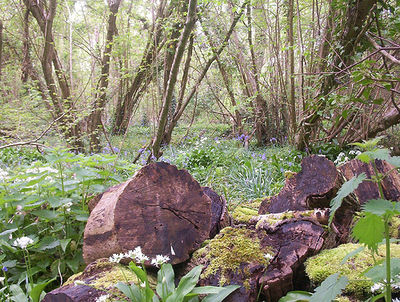Coppice: Difference between revisions
(Created page with "{{Category=Growing plants}} {{Category=Biofuel}} {{Category=Agroforestry}} 400px|thumb|right| Logs at Centurion's Copse, Brading, 2005. Many woody pla...") |
(Added some more links under the "Internal Links" section) |
||
| (13 intermediate revisions by 3 users not shown) | |||
| Line 1: | Line 1: | ||
=Basics= | |||
[[File: Coppice01.jpg|400px|thumb|right| Logs at Centurion's Copse, Brading, 2005. ]] | |||
Coppicing is the practise of cutting live trees in their dormant season and allowing them to regrow from the stump. | |||
Many woody plants resprout from the stump or root suckers when cut to the ground--we call the regrowth [http://en.wikipedia.org/wiki/Coppicing "coppice"], and the management system "coppicing". Many ancient cultures understood this plant behavior and managed coppice to produce their fuel, craft and building materials, livestock fodder, fencing, and much more. Any ag-based community should strongly consider this. | Many woody plants resprout from the stump or root suckers when cut to the ground--we call the regrowth [http://en.wikipedia.org/wiki/Coppicing "coppice"], and the management system "coppicing". Many ancient cultures understood this plant behavior and managed coppice to produce their fuel, craft and building materials, livestock fodder, fencing, and much more. Any ag-based community should strongly consider this. | ||
=Kickstarter video= | |||
Mark Krawczyk (www.keylinevermont.com and www.rivenwoodcrafts.com) and Dave Jacke ([http://www.edibleforestgardens.com/ Edible Forest Gardens]) have therefore decided to write "Coppice Agroforestry: Perennial Silviculture for the 21st Century." Coppice Agroforestry will serve as a detailed manual for foresters, farmers, craftspeople, and land managers describing the history, ecology, economics, design, and management of agroforestry systems based on the repeated harvest of small diameter wood products from resprouting tree stumps. Bridging ancient coppice traditions and cutting-edge agroecosystem design, Coppice Agroforestry will articulate a practical vision of forest management that integrates ecosystem health, economic viability, multi-generational tree crops, and diverse non-timber forest products. | Mark Krawczyk ([http://www.keylinevermont.com/ Keyline Vermont] and [http://www.rivenwoodcrafts.com Riven WoodCrafts]) and Dave Jacke ([http://www.edibleforestgardens.com/ Edible Forest Gardens]) have therefore decided to write "Coppice Agroforestry: Perennial Silviculture for the 21st Century." Coppice Agroforestry will serve as a detailed manual for foresters, farmers, craftspeople, and land managers describing the history, ecology, economics, design, and management of agroforestry systems based on the repeated harvest of small diameter wood products from resprouting tree stumps. Bridging ancient coppice traditions and cutting-edge agroecosystem design, Coppice Agroforestry will articulate a practical vision of forest management that integrates ecosystem health, economic viability, multi-generational tree crops, and diverse non-timber forest products. | ||
<html><iframe frameborder="0" height="410px" src="http://www.kickstarter.com/projects/coppiceagroforestry/dave-and-mark-write-a-coppice-agroforestry-book/widget/video.html" width="480px"></iframe></html> | <html><iframe frameborder="0" height="410px" src="http://www.kickstarter.com/projects/coppiceagroforestry/dave-and-mark-write-a-coppice-agroforestry-book/widget/video.html" width="480px"></iframe></html> | ||
=Uses and product ecology= | |||
* use of nut or fruit trees: produce wood and food (see: [http://opensourceecology.org/wiki/Nut_Breeding Nut Breeding]) | |||
* willow branches – many uses (examples: basket making, furniture, ornamental, streambank erosion control, fences, bio-energy,...) | |||
* to provide logs on which to grow [[mushrooms]] (caution: willow is a hyperaccumulator of heavy metals, and so are many mushrooms. This may potentiate the effect. Always monitor!) | |||
* supports biodiversity: birds, insects | |||
* in agroforestry: works as a wind brake: slows down evaporation from fields | * in agroforestry: works as a wind brake: slows down evaporation from fields | ||
* in agroforestry:creates diffuse light, better for field crops than glaring sunlight | * in agroforestry: creates diffuse light, can be better for field crops than glaring sunlight | ||
* | |||
* | =Internal Links= | ||
*[[Short Rotation Coppice]] | |||
=External Links= | |||
*[https://en.wikipedia.org/wiki/Coppicing The Wikipedia Page on Coppicing] | |||
[[Category: Agroforestry]] [[Category: Biofuel]] [[Category: Forestry]] [[Category: Growing plants]] | |||
Latest revision as of 05:23, 19 January 2021
Basics
Coppicing is the practise of cutting live trees in their dormant season and allowing them to regrow from the stump.
Many woody plants resprout from the stump or root suckers when cut to the ground--we call the regrowth "coppice", and the management system "coppicing". Many ancient cultures understood this plant behavior and managed coppice to produce their fuel, craft and building materials, livestock fodder, fencing, and much more. Any ag-based community should strongly consider this.
Kickstarter video
Mark Krawczyk (Keyline Vermont and Riven WoodCrafts) and Dave Jacke (Edible Forest Gardens) have therefore decided to write "Coppice Agroforestry: Perennial Silviculture for the 21st Century." Coppice Agroforestry will serve as a detailed manual for foresters, farmers, craftspeople, and land managers describing the history, ecology, economics, design, and management of agroforestry systems based on the repeated harvest of small diameter wood products from resprouting tree stumps. Bridging ancient coppice traditions and cutting-edge agroecosystem design, Coppice Agroforestry will articulate a practical vision of forest management that integrates ecosystem health, economic viability, multi-generational tree crops, and diverse non-timber forest products.
Uses and product ecology
- use of nut or fruit trees: produce wood and food (see: Nut Breeding)
- willow branches – many uses (examples: basket making, furniture, ornamental, streambank erosion control, fences, bio-energy,...)
- to provide logs on which to grow mushrooms (caution: willow is a hyperaccumulator of heavy metals, and so are many mushrooms. This may potentiate the effect. Always monitor!)
- supports biodiversity: birds, insects
- in agroforestry: works as a wind brake: slows down evaporation from fields
- in agroforestry: creates diffuse light, can be better for field crops than glaring sunlight
